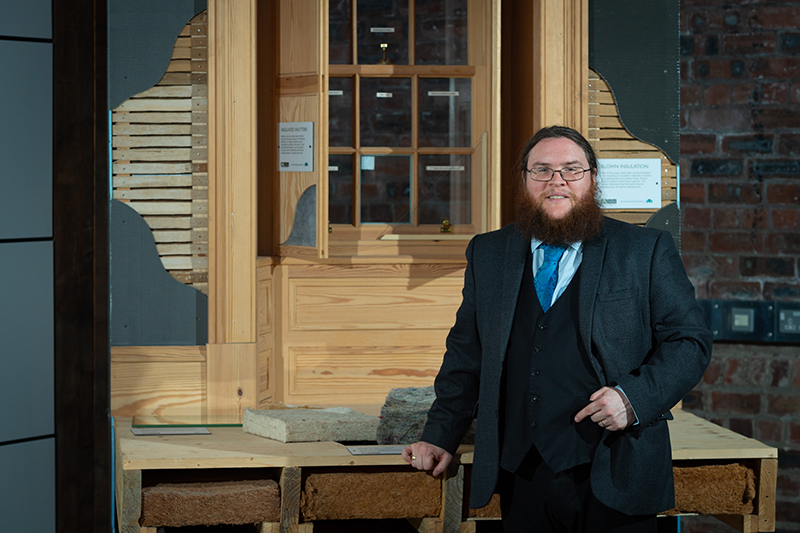
By Moses Jenkins, sector skills manager, Historic Environment Scotland
When thinking about the retrofit of our older building stock, it is important to get the terminology correct. There are 455,000 homes in Scotland which can be termed ‘traditionally constructed’. This is generally meant to mean buildings constructed before 1919 using methods and materials which are permeable to moisture, such as sandstone and brick walls, suspended timber floors, lime plaster, and mortar.
In contrast, modern construction often relies on materials such as steel, concrete, and cement which are less permeable and have different performance characteristics.
Traditionally constructed buildings are in many ways inherently sustainable. However, there is still a need to improve the thermal performance of traditional buildings through retrofitting in order to help with Scotland’s ambitious goal of reaching net zero by 2045. Retaining and improving these buildings is a better alternative to continuous demolition and rebuild, which would have a significant impact on our overall carbon output.
Maintaining the balance between old and new
Traditionally constructed buildings were designed to work in a way that preserved a balance between moisture movement and ventilation. Today, building occupants expect a greater level of thermal comfort than was the case when traditional buildings were constructed, something which needs to be taken into account when retrofitting.
Improving the thermal performance of traditional buildings through retrofit does not need to compromise a building’s historic significance; there is a middle ground to be found between maintaining historical significance and improving thermal comfort. Historic Environment Scotland has researched several methods and materials to improve thermal performance and seen success with a number of them – for example, we attained an 83% improvement in the performance of a mass masonry wall by installing wood fibre board insulation.
Similarly, we achieved an upper EPC Band C – up from a previous Band F – after retrofitting Holyrood Park Lodge in Edinburgh. In this project, there was a focus on improving thermal performance with materials appropriate to the building’s character and performance.
Preserving our heritage
Of course, as a heritage-centred organisation, we believe that retrofitting homes is important to keep Scotland’s history alive. From crofts to tenements and country houses, traditionally constructed homes tell a story about our past.
Whether these buildings are listed or not, they contribute to the local character of an area – which in many cases can be very distinct: consider the granite buildings in Aberdeen, Georgian homes in Edinburgh, or the Victorian structures in Inverness.
This also benefits tourism and local economies. To understand this, you need only look at the number of architecture-themed tours available throughout the country; people also often list Scotland’s historical structures as one of the first things they think of when describing our heritage.
Gaining the necessary skills
As retrofitting becomes more common, the need for skilled professionals becomes clear but – like many other sectors in Scotland – we are facing a skills gap. Traditional skills such as stonemasonry are unfortunately becoming all too scarce.
Skills to ensure buildings are in good repair prior to retrofit are vital to the success of efforts to improve energy efficiency.
The need for skilled and knowledgeable installers of measures and professionals to specify and oversee this retrofit work requires a considerable expansion in the workforce, as well as expanding knowledge and expertise amongst existing professionals.
Historic Environment Scotland is one of a number of organisations delivering the Level 3 Award in Energy Efficiency Measures for Older and Traditional Buildings. This qualification provides a necessary baseline knowledge of retrofit for traditional buildings including how they perform, appropriate measures for improvement, and avoiding technical risks.
Added benefits of traditional construction
The materials used to construct our traditional buildings are often of a higher quality than those used today. They are durable and long-lasting. With appropriate repair and maintenance, and sensitive thermal improvement, they will continue to perform well into the future.
It is possible to strike a balance between technical performance, heritage, and thermal improvement. To do this, we must ensure that those working in this area understand all the various factors to take into account when retrofitting traditional buildings – including why it’s so important.
Historic Environment Scotland have a wide range of published resources to support this including the Guide to Energy Retrofit of Traditional Buildings.
By retrofitting our traditionally constructed building stock, and improving its thermal performance, we are allowing an inherently sustainable resource to continue in use for another century or more. Our traditional buildings are an integral part of our built environment, our heritage, and will play a central part in our net zero future.








